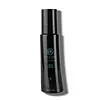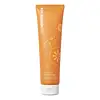What's inside
What's inside
 Key Ingredients
Key Ingredients

 Benefits
Benefits

 Concerns
Concerns

 Ingredients Side-by-side
Ingredients Side-by-side

Water
Skin ConditioningArgania Spinosa Kernel Oil
EmollientJojoba Oil/Wax Polyglyceryl-3 Esters
Propanediol
SolventOpuntia Ficus-Indica Seed Oil
EmollientNigella Sativa Seed Oil
EmollientDecyl Glucoside
CleansingHydrogenated Sunflower Seed Oil Polyglyceryl-3 Esters
EmulsifyingGlycol Distearate
EmollientCapryl/Capramidopropyl Betaine
CleansingGuar Hydroxypropyltrimonium Chloride
Skin ConditioningCitrus Aurantium Dulcis Oil
MaskingSodium Chloride
Masking1,2-Hexanediol
Skin ConditioningHydroxypropyl Methylcellulose
Emulsion StabilisingCaprylhydroxamic Acid
Hexanediol
SolventHydroxyacetophenone
AntioxidantCellulose
AbsorbentXanthan Gum
EmulsifyingGellan Gum
Melissa Officinalis Leaf Extract
Skin ConditioningDisodium Rutinyl Disulfate
AntioxidantHordeum Distichon Extract
Skin ProtectingCitric Acid
BufferingCitral
PerfumingFarnesol
PerfumingGeraniol
PerfumingLimonene
PerfumingLinalool
PerfumingCitrus Aurantium Amara Flower Oil
MaskingSodium Benzoate
MaskingWater, Argania Spinosa Kernel Oil, Jojoba Oil/Wax Polyglyceryl-3 Esters, Propanediol, Opuntia Ficus-Indica Seed Oil, Nigella Sativa Seed Oil, Decyl Glucoside, Hydrogenated Sunflower Seed Oil Polyglyceryl-3 Esters, Glycol Distearate, Capryl/Capramidopropyl Betaine, Guar Hydroxypropyltrimonium Chloride, Citrus Aurantium Dulcis Oil, Sodium Chloride, 1,2-Hexanediol, Hydroxypropyl Methylcellulose, Caprylhydroxamic Acid, Hexanediol, Hydroxyacetophenone, Cellulose, Xanthan Gum, Gellan Gum, Melissa Officinalis Leaf Extract, Disodium Rutinyl Disulfate, Hordeum Distichon Extract, Citric Acid, Citral, Farnesol, Geraniol, Limonene, Linalool, Citrus Aurantium Amara Flower Oil, Sodium Benzoate
Water
Skin ConditioningSodium Cocoyl Isethionate
CleansingSodium Cocoamphoacetate
CleansingCocamidopropyl Hydroxysultaine
CleansingSodium Chloride
MaskingAcrylates/Beheneth-25 Methacrylate Copolymer
Phenoxyethanol
PreservativeCitrus Aurantium Dulcis Oil
MaskingGlycol Distearate
EmollientGluconolactone
Skin ConditioningPropanediol
SolventGlycerin
Humectant1,2-Hexanediol
Skin ConditioningCitrus Aurantium Dulcis Peel Oil
MaskingSodium Benzoate
MaskingCitrus Aurantium Dulcis Fruit Water
MaskingCI 77891
Cosmetic ColorantCitrus Sinensis Fruit Extract
AntioxidantTriethyl Citrate
MaskingCaprylhydroxamic Acid
Citrus Aurantium Dulcis Fruit Extract
MaskingCitrus Limon Fruit Extract
MaskingHippophae Rhamnoides Kernel Extract
MaskingLycium Barbarum Fruit Extract
AstringentRosa Canina Fruit Extract
AstringentCalcium Gluconate
HumectantHelianthus Annuus Seed Oil
EmollientLeuconostoc/Radish Root Ferment Filtrate
AntimicrobialSodium Hydroxide
BufferingCI 15985
Cosmetic ColorantCitric Acid
BufferingPotassium Sorbate
PreservativeXanthan Gum
EmulsifyingSodium Citrate
BufferingLimonene
PerfumingLinalool
PerfumingWater, Sodium Cocoyl Isethionate, Sodium Cocoamphoacetate, Cocamidopropyl Hydroxysultaine, Sodium Chloride, Acrylates/Beheneth-25 Methacrylate Copolymer, Phenoxyethanol, Citrus Aurantium Dulcis Oil, Glycol Distearate, Gluconolactone, Propanediol, Glycerin, 1,2-Hexanediol, Citrus Aurantium Dulcis Peel Oil, Sodium Benzoate, Citrus Aurantium Dulcis Fruit Water, CI 77891, Citrus Sinensis Fruit Extract, Triethyl Citrate, Caprylhydroxamic Acid, Citrus Aurantium Dulcis Fruit Extract, Citrus Limon Fruit Extract, Hippophae Rhamnoides Kernel Extract, Lycium Barbarum Fruit Extract, Rosa Canina Fruit Extract, Calcium Gluconate, Helianthus Annuus Seed Oil, Leuconostoc/Radish Root Ferment Filtrate, Sodium Hydroxide, CI 15985, Citric Acid, Potassium Sorbate, Xanthan Gum, Sodium Citrate, Limonene, Linalool
 Reviews
Reviews

Ingredients Explained
These ingredients are found in both products.
Ingredients higher up in an ingredient list are typically present in a larger amount.
1,2-Hexanediol is a synthetic liquid and another multi-functional powerhouse.
It is a:
- Humectant, drawing moisture into the skin
- Emollient, helping to soften skin
- Solvent, dispersing and stabilizing formulas
- Preservative booster, enhancing the antimicrobial activity of other preservatives
Caprylhydroxamic Acid is a chelating agent.
Chelating agents help prevent metal ions from binding to other ingredients. This helps prevent unwanted reactions and effects from using the product.
Caprylhydroxamic Acid is often used with natural antimicrobial products as an alternative to preservatives.
Learn more about Caprylhydroxamic AcidCitric Acid is an alpha hydroxy acid (AHA) naturally found in citrus fruits like oranges, lemons, and limes.
Like other AHAs, citric acid can exfoliate skin by breaking down the bonds that hold dead skin cells together. This helps reveal smoother and brighter skin underneath.
However, this exfoliating effect only happens at high concentrations (20%) which can be hard to find in cosmetic products.
Due to this, citric acid is usually included in small amounts as a pH adjuster. This helps keep products slightly more acidic and compatible with skin's natural pH.
In skincare formulas, citric acid can:
While it can provide some skin benefits, research shows lactic acid and glycolic acid are generally more effective and less irritating exfoliants.
Most citric acid used in skincare today is made by fermenting sugars (usually from molasses). This synthetic version is identical to the natural citrus form but easier to stabilize and use in formulations.
Read more about some other popular AHA's here:
Learn more about Citric AcidCitrus Aurantium Dulcis Oil comes from the bitter orange, an orange native to Southeast Asia.
This orange is commonly used in cosmetics and food. It is a common ingredient for marmalade.
Citrus peels are often made up of mainly limonene, a fragrance with a citrus scent. They also contain flavonoids, which have anti-inflammatory properties.
Learn more about Citrus Aurantium Dulcis OilGlycol Distearate serves as a pearlizing or opacifying agent in cosmetic products.
It's often included in cleansers and haircare products to give them a lustrous or shimmering appearance.
It is derived from stearic acid, a natural fatty acid commonly found in vegetable oils and animal fats.
Glycol Distearate isn't fungal acne safe.
Learn more about Glycol DistearateLimonene is a fragrance that adds scent and taste to a formulation.
It's found in the peel oil of citrus fruits and other plants such as lavender and eucalyptus. The scent of limonene is generally described as "sweet citrus".
Limonene acts as an antioxidant, meaning it helps neutralize free radicals.
When exposed to air, oxidized limonene may sensitize the skin. Because of this, limonene is often avoided by people with sensitive skin.
The term 'fragrance' is not regulated in many countries. In many cases, it is up to the brand to define this term. For instance, many brands choose to label themselves as "fragrance-free" because they are not using synthetic fragrances. However, their products may still contain ingredients such as essential oils that are considered a fragrance.
Learn more about LimoneneLinalool is a fragrance and helps add scent to products. It's derived from common plants such as cinnamon, mint, citrus, and lavender.
Like Limonene, this ingredient oxidizes when exposed to air. Oxidized linalool can cause allergies and skin sensitivity.
This ingredient has a scent that is floral, spicy tropical, and citrus-like.
Learn more about LinaloolPropanediol is an all-star ingredient. It softens, hydrates, and smooths the skin.
It’s often used to:
Propanediol is not likely to cause sensitivity and considered safe to use. It is derived from corn or petroleum with a clear color and no scent.
Learn more about PropanediolSodium Benzoate is a preservative. It's used in both cosmetic and food products to inhibit the growth of mold and bacteria. It is typically produced synthetically.
Both the US FDA and EU Health Committee have approved the use of sodium benzoate. In the US, levels of 0.1% (of the total product) are allowed.
Sodium benzoate works as a preservative by inhibiting the growth of bacteria inside of cells. It prevents the cell from fermenting a type of sugar using an enzyme called phosphofructokinase.
It is the salt of benzoic acid. Foods containing sodium benzoate include soda, salad dressings, condiments, fruit juices, wines, and snack foods.
Studies for using ascorbic acid and sodium benzoate in cosmetics are lacking, especially in skincare routines with multiple steps.
We always recommend speaking with a professional, such as a dermatologist, if you have any concerns.
Learn more about Sodium BenzoateChances are, you eat sodium chloride every day. Sodium Chloride is also known as table salt.
This ingredient has many purposes in skincare: thickener, emulsifier, and exfoliator.
You'll most likely find this ingredient in cleansers where it is used to create a gel-like texture. As an emulsifier, it also prevents ingredients from separating.
There is much debate on whether this ingredient is comedogenic. The short answer - comedogenic ratings don't tell the whole story. Learn more about comegodenic ratings here.
The concensus about this ingredient causing acne seems to be divided. Research is needed to understand if this ingredient does cause acne.
Scrubs may use salt as the primary exfoliating ingredient.
Learn more about Sodium ChlorideWater. It's the most common cosmetic ingredient of all. You'll usually see it at the top of ingredient lists, meaning that it makes up the largest part of the product.
So why is it so popular? Water most often acts as a solvent - this means that it helps dissolve other ingredients into the formulation.
You'll also recognize water as that liquid we all need to stay alive. If you see this, drink a glass of water. Stay hydrated!
Learn more about WaterXanthan gum is used as a stabilizer and thickener within cosmetic products. It helps give products a sticky, thick feeling - preventing them from being too runny.
On the technical side of things, xanthan gum is a polysaccharide - a combination consisting of multiple sugar molecules bonded together.
Xanthan gum is a pretty common and great ingredient. It is a natural, non-toxic, non-irritating ingredient that is also commonly used in food products.
Learn more about Xanthan Gum